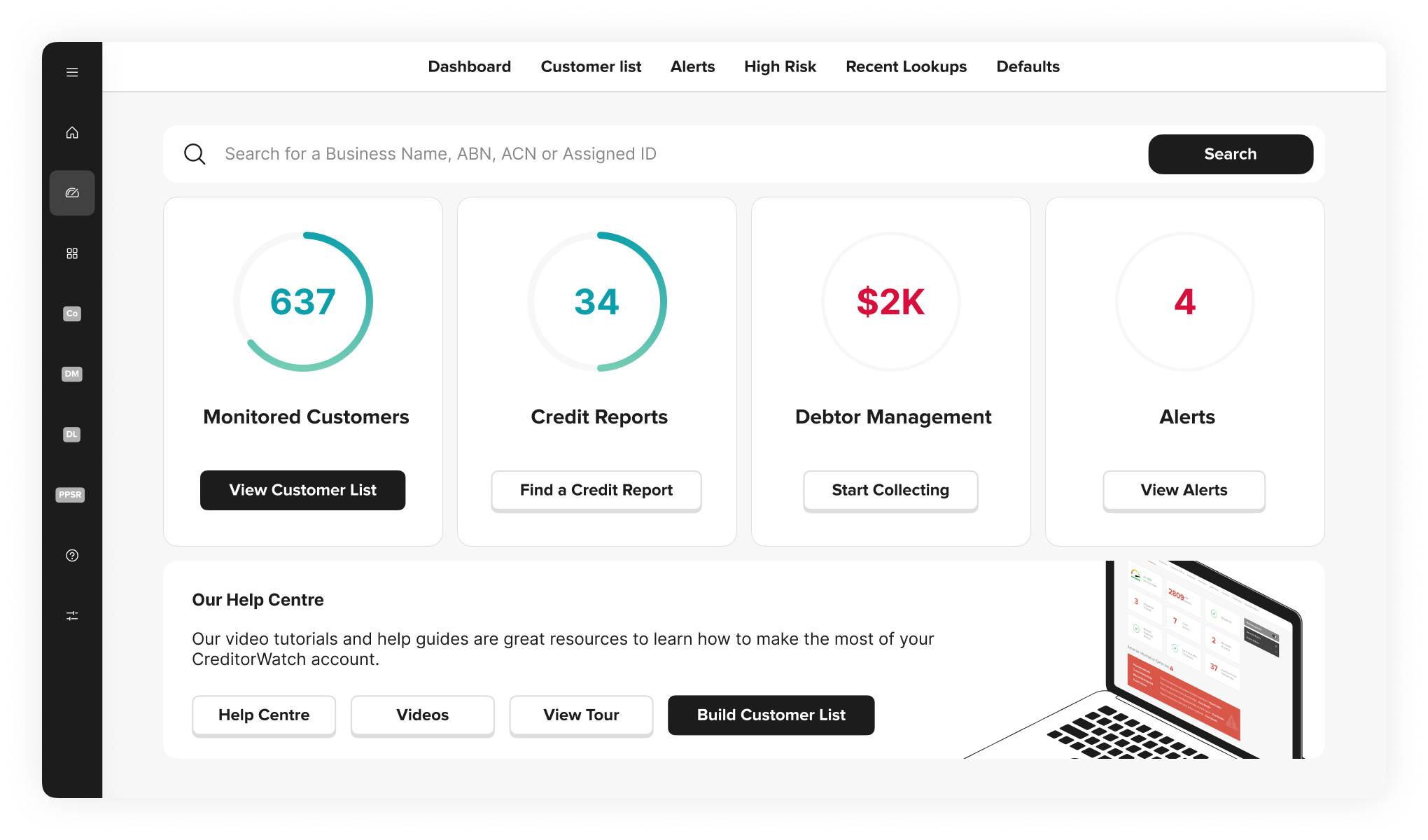Businesses in Australia are currently experiencing challenging economic conditions. When performing customer due diligence, it’s important to note that there are always tell-tale signs that companies display when in financial distress. Identifying these warning signs early could mean the difference between healthy cash flow for your business or facing the same financial distress.
Factors triggering financial distress for Australian businesses
Domestic companies face a multifaceted set of challenges that are expected to continue into 2024, from rising interest rates and unemployment, to a weakening retail sector and pessimistic consumer sentiment. As evidence, the retail sector experienced a 0.2% decline in sales in October. Although Black Friday sales were anticipated to provide a boost, spending in cafes, food services, and takeaway food declined, signalling that consumers are struggling under financial strain. Further, both Business Confidence and Consumer Sentiment measures (from NAB and Westpac, respectively) revealed increasing pessimism among those surveyed. The latest Australian Bureau of Statistics (ABS) data showed that, in seasonally adjusted terms, unemployment increased to 3.7% in October 2023. When paired with last months’ higher-than-expected inflation data, there is clear evidence of continued weakening within the economy. These factors compelled the Reserve Bank of Australia (RBA) to hold the cash rate in its December 2023 meeting. However, inflation is still not within the RBAs target range of 2-3%. Economists from a Big Four Bank still believe further cash rate increases are on the horizon, which will put even more pressure on household budgets. Further, while overseas inflation rates in major economies continue to fall, Australia’s higher migration numbers (proportionally) increase the risk that inflation may be harder to tame. Another rate hike should see consumer confidence, retail sales and discretionary spending continue to slide, spelling bad news for Australian businesses. In fact, CreditorWatch’s business failure rates are tipped to increase over the next 12 months to around 5.8%.11 signs a business is facing financial distress:
1. Worsening payment habits The first sign that a business is struggling with cash flow is that its time-to-payment starts to increase, its payment cycles become inconsistent and/or it fails to meet its payment terms. A one-off incident with clear communication regarding why a payment is late may not be a cause for concern, but a worsening pattern of payment behaviour typically is. 2. Deteriorating communication Another red flag that an entity is in financial distress is that when you try to reach out regarding a missed payment, you struggle to get in contact with its operators. Alternatively, you may get continuous excuses for late payments. When communication around payments starts to deteriorate, it is often a sign that the operators are avoiding you as the business has cash flow issues. 3. Payment defaults If an entity does not pay its bills, a payment default may be lodged against them. This adverse event will stay on a company’s credit report for up to five years and can negatively impact its credit score. Over 50% of businesses that incur a payment default will go into administration within 18 months. A clear indicator of financial distress is if you’re tracking the payment behaviour of an entity or performing a company credit check on a new supplier and notice a payment default on its credit file. Further, if you observe that its credit score has decreased or is lower than expected, it’s worth investigating whether a payment default is the culprit. 4. Adverse cross directorships When an individual is a director of multiple companies, this is known as a cross directorship. Often, creditors don’t know that the director of a company they are working with is also the director of one or multiple companies. If a director has an adverse action registered against one of their companies, is shifting assets around, or is engaging in illegal phoenix activity, you may be totally unaware. This behaviour is also a clear sign of financial distress that will likely impact your business. It is crucial you perform director due diligence to identify directors with previously failed or failing companies and other indicators of potential phoenix activity. 5. Multiple credit enquiries If you notice a higher volume of credit enquiries on a company’s credit file, this may indicate financial distress. An increase in credit applications in rapid succession can signal the entity is ‘credit hungry’, struggling to secure finance and has poor cash flow. 6. Listed mercantile enquiries A mercantile enquiry is another adverse event that can be registered against a business under financial distress. Similar to a payment default, a mercantile enquiry is a black mark on a company credit file left when a mercantile agent (such as a debt collection agency) accesses the report. If an entity has a mercantile enquiry listed in its credit history, it’s a sign it has outstanding debts and may be struggling financially. 7. Director personal insolvency The personal insolvency of a director can also be a sign of financial distress within a business. If the individual responsible for an entity’s management and decision-making faces severe challenges, this could similarly affect any business they are involved in. While personal issues can occur separate to a business’s operations, it’s worth noting this as a potential red flag. 8. Court actions A court action lodged against a business by a supplier or other creditor is another factor to keep an eye out for when doing your due diligence. Actions taken by the courts against a business regarding any money owed get lodged on a company credit file as a ‘court action’. The entity has been legally declared to have outstanding debts. 9. Winding up notices A winding up notice typically indicates that a business faces serious financial issues and may be at risk of compulsory liquidation. Winding up notices are a formal notice issued by the ATO following failure to act upon statutory demand. The entity must act before a specified court date to repay any outstanding debts, or the business will be – as the name suggests – would up. 10. Insolvency notices When a company becomes insolvent, ASIC publishes this announcement as an insolvency notice. This notice informs creditors, shareholders, and the public of the financial distress of the entity. If you have debtors with insolvency notices, it is crucial you take immediate action to improve your chances of recovering any money owed. 11. Administration or liquidation The final stages of severe financial distress within a business involve the appointment of an administrator. This outcome is referred to as being ‘in administration’. In this instance, the administrator investigates the best options the entity may take (restructure, being wound up, etc.) and provides a detailed report to creditors. The company will go into liquidation if nothing can be done to help. At this stage, an entity’s assets are converted into cash, and used to repay as many debts as possible. Unfortunately, it is unlikely that any creditors will retrieve the complete amount of their owed funds.What businesses can do if they spot the warning signs
If one or more of these signs of financial distress are all too familiar, one of the best strategies you can take is utilising credit and debit management tools, such as the suite offered by CreditorWatch. Our sophisticated reports and tools allow businesses to monitor customer and supplier payment behaviour, be notified 24/7 of any early warning signs, and take proactive measures to mitigate cash flow risks, including:- Business Credit Checks – Examine the credit history and credit scores of entities before you engage with them.
- RiskScore – Assess a business’s likelihood of default in the next 12 months using more than 11 million monthly trade lines, business demographic risk data, and classic risk drivers (court actions, ASIC insolvency notices, etc).
- Financial Risk Assessments – Using company financials, ASIC records and our exclusive trade payment data, the Financial Risk Assessment offers a tailored analysis of the financial performance of an entity. This assessment provides succinct and reliable analysis from a CA or CPA, as well as information on how you may better protect your business.
- Director Due Diligence – Know whether a director engages in risky behaviour, such as adverse cross directorships or illegal phoenix activity ahead-of-time.
- DebtorLogic – Our interactive debt management system that helps to reduce payment times, improves your overall collection rate and offers a complete analysis of your aged trial balance. Identify your customers’ payment trends across the market and compare the data to the rest of the industry to identify slow paying businesses.
Business risk
cash
Cash Flow
Credit Management
insolvency
insolvency risk
risk management

Head of Media & Communications
Michael joined CreditorWatch in July 2021. He has more than 20 years’ experience in business journalism, marketing and communications strategy and digital content development. He is passionate about communicating to the business community how CreditorWatch’s product suite can help them grow and protect their companies.
14-Day Free Trial
Get started with CreditorWatch today
Take your credit management to the next level with a 14-day free trial.

